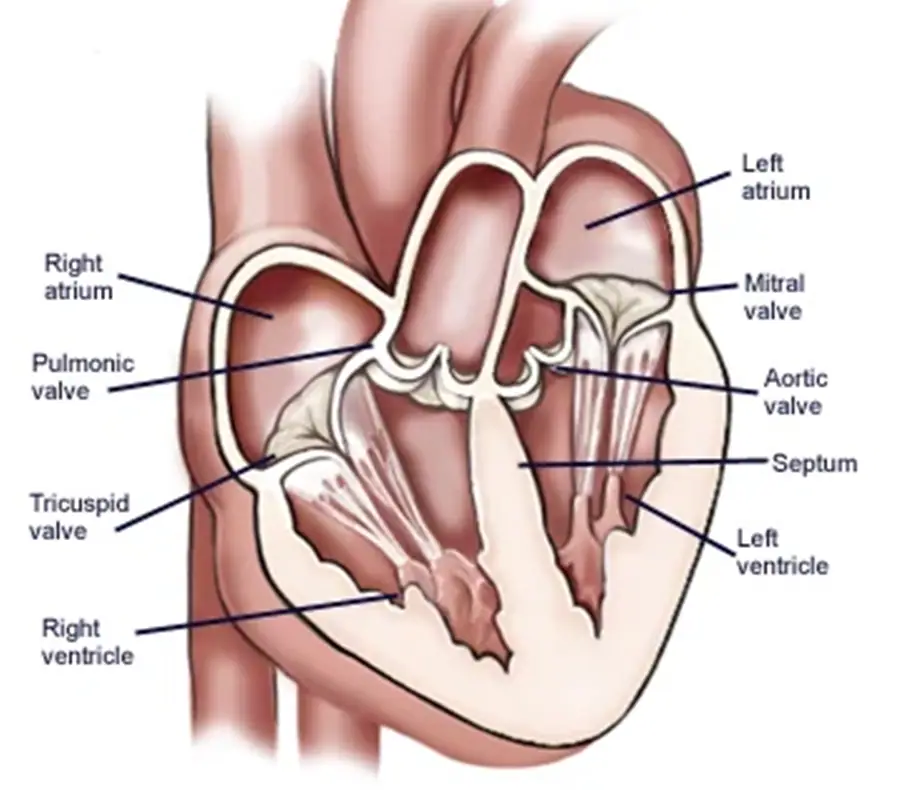Heart valve disease is when one or more of your heart valves don’t work like they should.
What are heart valves?
The heart consists of four chambers, two atria (upper chambers) and two ventricles (lower chambers). There is a valve through which blood passes before leaving each chamber of the heart. The valves prevent the backward flow of blood. These valves are actual flaps that are located on each end of the two ventricles (lower chambers of the heart). They act as one-way inlets of blood on one side of a ventricle and one-way outlets of blood on the other side of a ventricle. Normal valves have three flaps, except the mitral valve, which has two flaps. The four heart valves include the following:
- tricuspid valve: located between the right atrium and the right ventricle
- pulmonary valve: located between the right ventricle and the pulmonary artery
- mitral valve: located between the left atrium and the left ventricle
- aortic valve: located between the left ventricle and the aorta

How do the heart valves function?
As the heart muscle contracts and relaxes, the valves open and shut, letting blood flow into the ventricles and atria at alternate times. The following is a step-by-step illustration of how the valves function normally in the left ventricle:
After the left ventricle contracts, the aortic valve closes and the mitral valve opens, to allow blood to flow from the left atrium into the left ventricle.
As the left atrium contracts, more blood flows into the left ventricle.
When the left ventricle contracts, the mitral valve closes and the aortic valve opens, so blood flows into the aorta.
What is heart valve disease?
There are several types of heart valve disease. The main problems are caused by the valve not opening fully or the valve not closing properly:
- If the valve doesn’t open fully, it will block or restrict the flow of blood. This is called valve stenosis or valve narrowing.
- If the valve doesn’t close fully, the blood will leak back into the heart instead of forwards into the body. This is called valve incompetence, valve regurgitation or a leaky valve.
Heart valves can develop both regurgitation and stenosis at the same time and more than one heart valve can be affected simultaneously. When heart valves fail to open and close properly, the implications for the heart can be serious, possibly hampering the heart’s ability to pump blood adequately through the body. Heart valve problems are one cause of heart failure. The mitral and aortic valves are most often affected by heart valve disease.
These problems can put extra strain on your heart and make your heart work harder. This can cause you to have symptoms like feeling more tired and out of breath. And over time, it can increase your risk of having a heart attack, a stroke and other heart conditions.
What causes heart valve disease?
The main causes of heart valve disease are:
- being born with an abnormal valve or valves (congenital heart disease)
- having had rheumatic fever
- cardiomyopathy – a disease of the heart muscle
- damage to the heart muscle from a heart attack
- getting older
- a previous infection with endocarditis.
What are the symptoms of heart valve disease?
Some people with heart valve disease don’t have any symptoms, other people can have multiple symptoms. There is no link between how serious your heart valve disease is and how many symptoms you feel or how serious your symptoms are. You can have serious symptoms and mild heart valve disease or the opposite, everyone’s symptoms are different.
Some of the common symptoms are:
- shortness of breath and being breathless
- feeling weak or dizzy
- discomfort in your chest
- swollen ankles and feet
- being unusually tired
- palpitations (a fluttering or pounding feeling in your chest or neck).
How is heart valve disease diagnosed?
Heart valve disease can be detected by your doctor if your heart sounds heard through a stethoscope are abnormal. This is typically the first step in diagnosing your heart valve disease. A heart murmur can often indicate valve regurgitation or stenosis. To further diagnose your specific heart valve condition and the extent of valve damage, your doctor may use one of the following tests:
- Electrocardiogram (ECG or EKG)
- Echocardiogram (Echo)
- Two-dimensional echocardiogram (2D Echo)
- Transesophageal echocardiogram (TEE)
- Chest X-ray
- Cardiac catheterization
- Magnetic resonance imaging (MRI)
- Computed Tomography (CT) Angiography
How is heart valve disease treated?
Heart valve disease is a lifelong condition. However, many people have heart valve defects or disease but don’t have symptoms. The condition may stay the same throughout your life and not cause any problems. Or, the condition may slowly get worse until you start to notice symptoms. If not treated, heart valve disease can cause heart failure or other life-threatening conditions.
Your healthcare provider may recommend healthy lifestyle changes or medicine first to treat symptoms, which may delay problems. Eventually, you may need to have your faulty heart valve repaired or replaced. After repair or replacement, you’ll still need certain medicines and regular checkups with your doctor.
Heart-healthy lifestyle changes
Healthy lifestyle changes include:
- Choosing heart-healthy foods
- Aiming for a healthy weight
- Managing stress
- Getting regular physical activity
- Quitting smoking
Before starting any exercise program, ask your doctor about what level of physical activity is right for you.
Medicines
Your doctor may prescribe medicines to relieve the symptoms of your heart valve disease, prevent it from getting worse, or treat other heart problems that can affect your heart valves. These may include:
- Medicines to control high blood pressure, such as diuretics and vasodilators, to ease pressure on the heart and reduce the amount of work the heart must do to pump blood
- Medicines to control the heart rate
- Blood thinners to treat or prevent blood clots
- Antibiotics to treat infections that cause heart inflammation or prevent rheumatic fever
- Prostaglandin for newborns to keep certain pathways of the heart open and maintain blood flow to the body
Heart valve repair
Your doctor may recommend heart valve repair if you have new symptoms of heart valve disease or your current symptoms get worse.
The various ways that heart surgeons repair heart valves are listed below. While most require surgery, some minimally invasive options are becoming available.
- Fixing valve flaps: Surgeons may sew flaps together, reshape flaps, patch tears, reattach loose flaps, or split apart flaps that have fused. These procedures are called valvuloplasty.
- Inflating a balloon: This allows blood to pump blood through a valve or stretch a valve opening. Valvuloplasty may also involve a balloon.
- Placing a stent: This allows blood to flow or plugs a leaking valve.
- Implanting a device to treat mitral valve regurgitation: This can be used for people who should not have open-heart surgery.
- Removing calcium deposits: Obstructions such as clumps of bacteria or tumors can also be removed.
- Repairing supporting structures: Replacing or shortening the cords that give the valves support allow the valve to close properly.
- Tightening or strengthening the valve base: This prevents the tissue from sagging or leaking. Surgeons may attach a plastic ring. These procedures are called annuloplasty.
Heart valve repair can improve symptoms, but sometimes problems return.
Possible complications of heart valve repairs include valve damage or leakage, blood vessel injury, cardiac compression, and stroke.
Heart valve replacement
Sometimes faulty or diseased heart valves cannot be repaired and must be replaced.
Your surgeon will replace the faulty or diseased valve with either a mechanical or a biological heart valve. Your team of doctors will work with you to determine whether a mechanical or a biological valve is best for you, depending on your age, risk factors, and other medical conditions.
- Biological valves, also called tissue valves, are made from animal tissue and may have man-made parts as well. Although tissue valves do not require blood thinners, they do not last as long and may have to be replaced.
- Mechanical valves are made from carbon or other sturdy material, so they last longer than biological valves and usually do not have to be replaced. However, mechanical valves require you to take blood-thinning medicines for the rest of your life. These valves may also carry additional risks during pregnancy.
Valves can be replaced during open-heart surgery or with a minimally invasive procedure using a catheter — a thin tube threaded through a blood vessel to the heart. A common example of the procedure using a catheter is transcatheter aortic valve replacement (TAVR). TAVR, which is sometimes called transcatheter aortic valve implantation (TAVI), replaces the aortic valve to treat aortic stenosis.
The risks of heart valve replacement include stroke, blood clots, damage and bleeding where the catheters were inserted, and injury to the kidneys or the heart. Sometimes the new valve leaks because it does not fit well.
Living with heart valve disease
Many people with heart valve disease can live their normal life but everyone will be affected differently. It is important to check what you can do with your doctor. They will be able to advise you on work, exercise, diet and any other concerns or questions you have.
Most people can work and do some form of exercise. Being physically active won’t improve how your valve works but it is good for your overall health. It can help boost your mood and help you sleep better.

